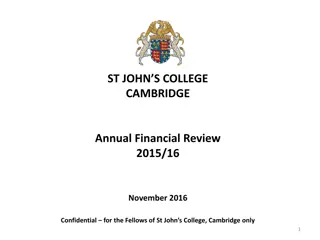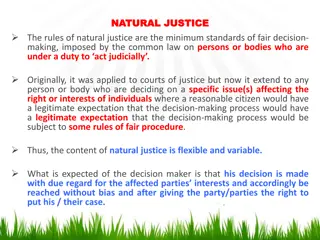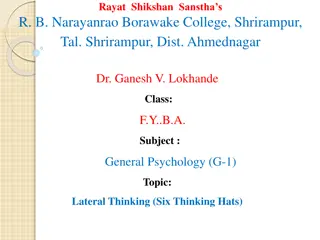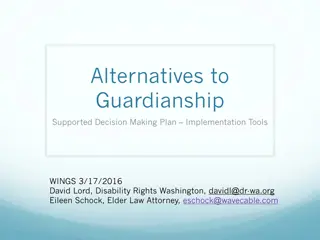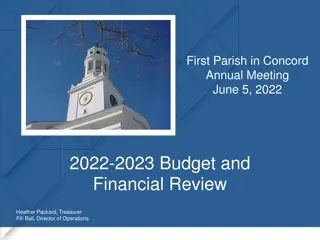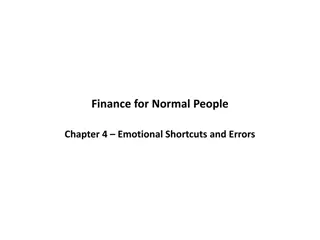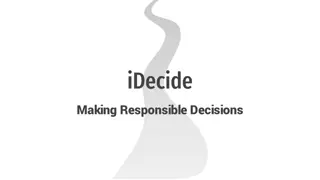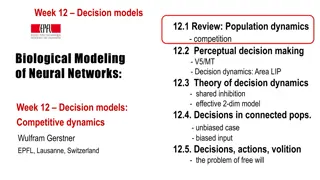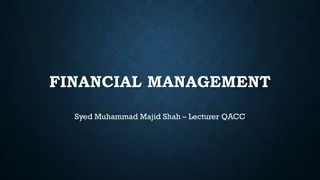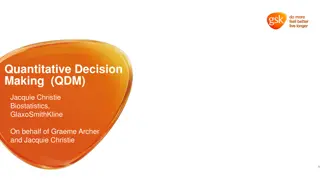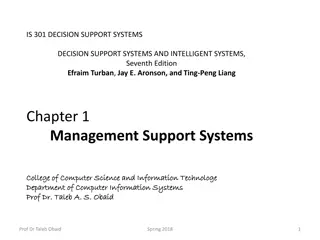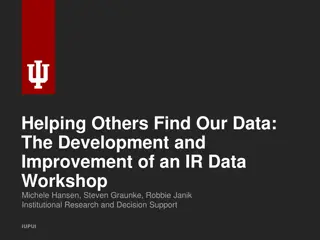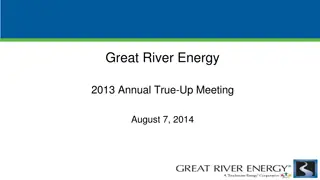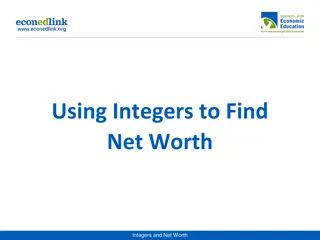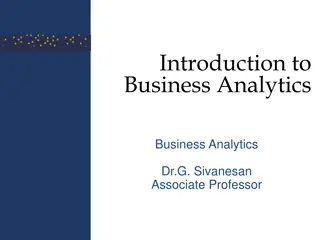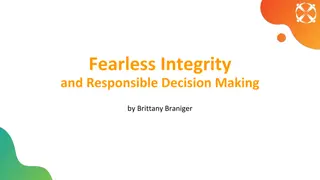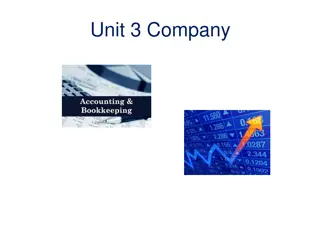Understanding Future Worth and Annual Worth in Financial Decision-Making
Exploring the concept of Future Worth (FW) in financial analysis, this content discusses its importance in decision-making processes for future values. It covers examples like retirement planning and capital needs assessment, emphasizing the significance of converting money values into the future. The equivalence analysis and benefit-cost analysis further illustrate how FW aids in assessing net benefits. Additionally, practical exercises and real-life scenarios, such as college education cost-benefit analysis, demonstrate the application of FW calculations in financial planning.
Download Presentation

Please find below an Image/Link to download the presentation.
The content on the website is provided AS IS for your information and personal use only. It may not be sold, licensed, or shared on other websites without obtaining consent from the author. Download presentation by click this link. If you encounter any issues during the download, it is possible that the publisher has removed the file from their server.
E N D
Presentation Transcript
Future Worth and Annual Worth Jung-woo Sohn (jzs177@psu.edu)
Future worth (FW) Decision-makings in the future Value analysis Need for conversion of money values into the future Again, this is about comparison! Definition The future value of all the cashflows pertaining to the project
Future worth: What is it good for? Decision-makings in the future Financial decision-makings rather than engineering (or project-based) decision-makings Example: Retirement planning: Savings of $10,000 needed after 5 years Financial planning: Firm A needs a capital pool of $1,000,000 after 10 years Simply, FW is the dollar amounts in the future
Future worth and the equivalence analysis Finding the future value (or future sum) ? from a cashflow diagram/table How do you find ??
Future worth and the equivalence analysis Benefit and cost analysis Benefit: ?????????? Costs: ??????? Future worth (net benefit):
In-class exercise: Finding ??? Assume annual interest rate of 6% ?????????? 252 + 119 + 636 ??????? 669 + 281 + 300 Future worth ?? (net benefit): ??= 1007 1250 = 243 Note: ??= 753 934 = 181
Example: college education Jane begins her four years of college to earn a BS degree. The annual cost of education is expected to be $15,000. The BS degree is likely to enable her to earn $10,000 more (in relation to if she did not have the degree) per year during her professional career of 30 years. What will be her ?? for her education and the career? Assume the interest rate of 8% per year.
Example: college education ???= 10000 ?/?,8%,30 ???= 15000 ?/?,8%,4 ?/?,8%,30 Or ???= 15000 ?/?,8%,4 (?/?,8%,34) ?? = ??? ???= 10000 113.283 15000 4.506 10.063 = 1,132,830 680,119 = 452,711
Future worth: when to use Note that PW analysis and FW analysis are equivalent When does FW analysis become useful, then? When future is important Dollar amount written in terms of the future Pay attention to the time for decision-makings Mostly financial planning cases Building a retirement equity, for example PW analysis is more frequently used Nature of future: involves uncertainty Comparisons of mutually exclusive projects The best choice will be the same whether PW or FW analysis
Annual worth (AW): Annual Equivalence (AE) Meaning of AW: The equivalence net cash inflow each year over the useful life Why AW analysis? Benefits/costs per year (or per unit period) Example) $10,000 value right now vs. $1,200 value per year over 10 years Good for planning Most organizations operate with annual plans Example) Based on the annual revenue of $10,000, $1,300 can be allocated annually for the project investment
Annual worth: simple examples ? = ? (?/?,?,?) ? = ? (?/?,?,?) ? =???
Annual worth and the equivalence analysis annual interest rate of 6% Two-step process: Conversion to ? or ? first Then conversion to ? In this example: ? = 181 or ? = 243 How do you find ?? ? = ? ?/?,6%,5 181 0.2374 ? = ? ?/?,6%,5 243 0.1774 -42.9694 vs. -42.9308
Example: lotto vs. salary Judy has won $400,000 in a lottery. Compare this windfall with her husband s annual salary of $40,000, if he expects to continue in his job for the next 25 years. Assume 6% of annual interest rate Annual Worth of the lottery? ?? = 400000 ?/?,6%,25 = 400,000 0.0782 $31,280 Who is making more money?
Example: AW benefit and AW cost Determine the annual worth of a 10-year project whose first cost is $12,000, annual benefit is $2,500, and salvage value is $2,000. Assume an annual interest of 8% per year Consider AW benefits and AW costs ?? = ??? ??? ?? = 2500 + 2000 ??,8%,10 12000 ??,8%,10 = 2500 + 2000 0.0690 12000 0.1490 2500+138-1788 = 850
Example: Purchasing a car revisited Harry is buying a new car. He is considering Honda Accord, Chevy Prizm, and Plymouth Acclaim, each with a seven-year useful life. Given the following data, which one should he buy if the decision criterion is annual worth? Assume an annually compounded interest rate of 9% per year. Car First Cost Annual Cost Salvage Value Honda Accord $20,000 $300 $3,000 Chevy Prizm $18,000 $500 $2,000 Plymouth acclaim $17,500 $750 $1,500
Example: Purchasing a car revisited ????????= 3000 ?/?,9%,7 20000 ?/?,9%,7 300 = 3000 0.1087 20000 0.1987 300 326-3974-300 = -3948 ???????= 2000 ?/?,9%,7 18000 ?/?,9%,7 500 = 2000 0.1087 18000 0.1987 500 217 3577 500 = -3860 ?????????= 1500 ??,9%,7 17500 ??,9%,7 750 = 1500 0.1087 17500 0.1987 750 163 3477 750 = -4064
Example: purchasing a car revisited ??????? ?????? = 20000 + 300 ?/?,9%,7 3000 ?/?,9%,7 = 2000 + 300 5.033 3000 0.5470 = ????? ??????? ?????= 18000 + 500 ?/?,9%,7 2000 ?/?,9%,7 = ????? ??????? ???????= 17500 + 750 ?/?,9%,7 1500 ?/?,9%,7 = ?????
Annual Worth and analysis period Does AW analysis needs equal analysis periods between projects? No AW is already converted to *annual* cashflow No need for LCM-based analysis period calibration
Annual Worth and analysis period Which choice will be the best option in terms of AW analysis? Assume yearly interest rate of 9%. Choice Fist cost Annual operating cost Useful life in years Salvage value Machine A $3,000 $200 2 $250 Machine B 8,000 100 4 500 Machine C 5,000 150 3 300
Annual worth and analysis period Machine A ?? = 250 ?/?,9%,2 3000 ?/?,9%,2 + 200 = 250 0.4785 3000 0.5685 200 = 120 1706 200 = 1786 Machine B ?? = 500 ?/?,9%,4 {8000 ?/?,9%,4 + 100} = 500 0.2187 8000 0.3087 100 = 109 2470 100 = 2461 Machine C ?? = 300 ?/?,9%,3 5000 ?/?,9%,3 + 150 = 300 0.3051 5000 0.3951 150 = 92 1976 150 = 2034
Unequal lives: PW analysis PW analysis results: Over 12 years ???= 12788 ???= 17615 ???= 14563











